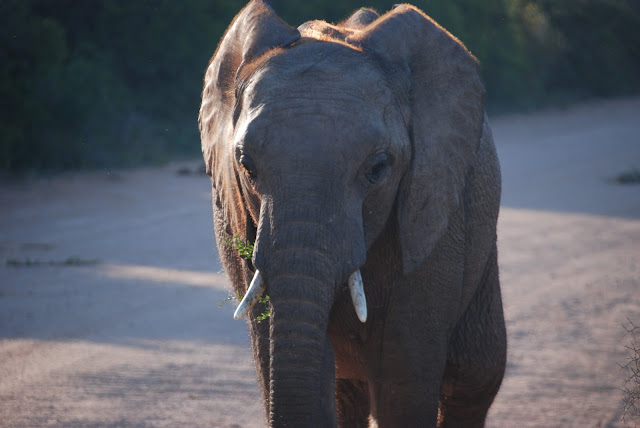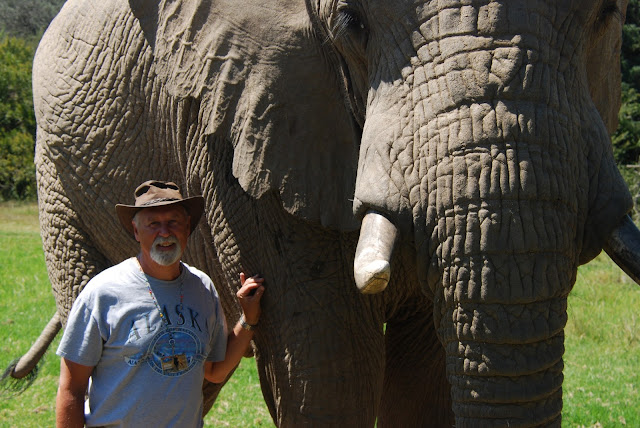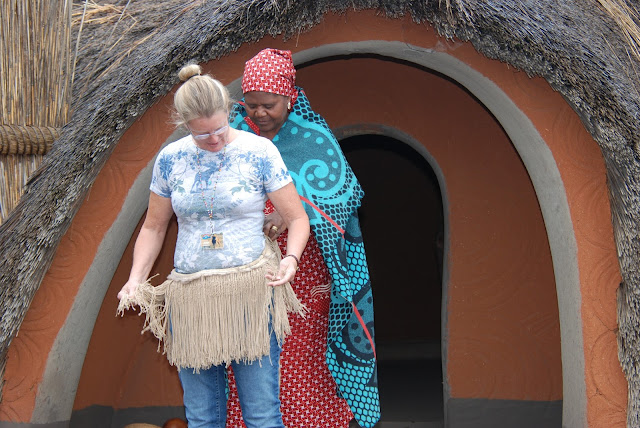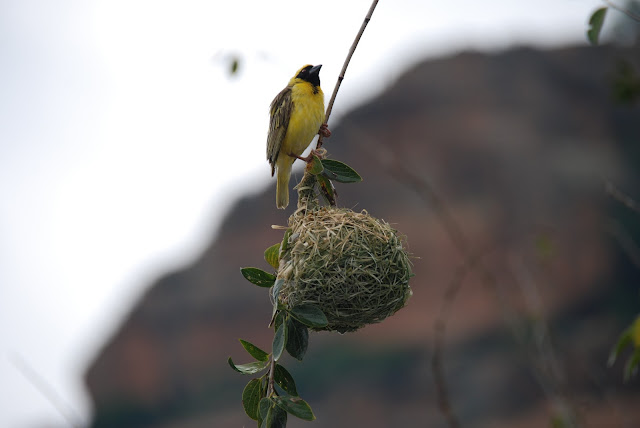ADDO
Addo Elephant National Park is a diverse wildlife conservation park situated close to Port Elizabeth in South Africa and is one of the country's 19 national parks. It currently ranks third in size after Kruger National Park and the Kgalagadi Transfrontier Park. The original section of the park was founded in 1931, in part due to the efforts of Sydney Skaife, in order to provide a sanctuary for the eleven remaining elephants in the area. The park has proved to be very successful and currently houses more than 600 elephants and a large number of other mammals. The original park has subsequently been expanded to include the Woody Cape Nature Reserve that extends from the Sundays River mouth towards Alexandria and a marine reserve, which includes St. Croix Island and Bird Island, both important breeding habitat for gannets and penguins, not to mention a large variety of other marine life. Bird Island is home to the world's largest breeding colony of gannets - about 120,000 birds - and also hosts the second largest breeding colony of African penguins, the largest breeding colony being St. Croix island. These marine assets form part of the plan to expand the 1,640 km² Addo National Elephant Park into the 3,600 km² Greater Addo Elephant National Park.
The expansion will mean not only that the park contains five of South Africa's seven major vegetation zones (biomes), but also that it will be the only park in the world to house Africa's "Big 7" (elephant, rhinoceros, lion, buffalo, leopard, whale and great white shark) in their natural habitat.
Here are pictures of what we saw in Addo National Park!
This was the largest elephant we saw - HUGE!
WOW!
As we had been watching the elephants above by the watering hole,
These came behind us right next to our RV!
A crowned lapwing kronenkiebitz
Shrike
Addo had a lot of warthogs!
A Kudu
Leopard Tortoise
Whalberg's Eagle
Water Buffalo
Known in Africa as one of the big five, ‘The Black Death’ or ‘widowmaker’, the African buffalo is widely regarded as a very dangerous animal as it gores and kills over 200 people every year.Buffaloes are sometimes reported to kill more people in Africa than any other animal, although the same claim is also made of hippos and crocodiles. Buffaloes are notorious among big game hunters as very dangerous animals, with wounded animals reported to ambush and attack pursuers.

Kudu
The next morning we saw this Blackbacked Jackel
Then as we rounded a corner
We were confronted with this!!
We pulled to the side of the road, shut the engine off and sat there watching!
This young one came along headed right for us - Head on!!
Now he was CLOSE!!!
Later we saw these by another water hole!

This Kudu spun around a ran along this berm.
Tsessebe
A Termite Mound
Fresh Kill from the night
Helmeted Guineafowl
Dung Beetle
Impala
Up Close Again!
This White Rhino had been shot with a tranquilizer gun and his horns cut
by poachers when he was rescued!
They do grow back if the animal survives - but very slowly!
He Does Not like Humans and chased one of the safari vehicles
our customers were in this day!! - I wonder Why!
Since 2008 poachers have killed at least 5,940 African rhinos......
Rhino poaching is currently at a crisis point. By the end of 2015, the number of African rhinos killed by poachers had increased for the sixth year in a row with at least 1,338 rhinos killed by poachers across Africa in 2015. These statistics are compiled by International Union for Conservation of Nature (IUCN) Species Survival Commission’s African Rhino Specialist Group (AfRSG).South Africa has by far the largest population of rhinos in the world and is an incredibly important country for rhino conservation. However rhino poaching levels have dramatically escalated over recent years. The below graph shows the exponential increase in poaching from 2007 - 2015.
1,175 rhinos were poached in South Africa during 2015, a slight decrease on the previous year when a record 1,215 rhinos were illegally killed. This is the first time the country has recorded a dip in poaching levels since 2007, when the rate of poaching began to escalate rapidly.
Although it is encouraging to see South Africa’s poaching levels fall slightly, poaching losses are still extremely high. 40 fewer rhinos killed in 2015 than in 2014 is statistically insignificant when you’re talking such large numbers of poaching deaths.

Above: Graph showing South African rhino poaching statistics using data published by South African Department of Environmental Affairs (2016)
Worryingly, the crisis has spread to neighboring countries in southern Africa, with Namibia and Zimbabwe experiencing an exponential increase in poaching. During 2015, Namibia lost 80 rhinos to poaching, up from 25 in 2014 and just two in 2012. In Zimbabwe, it is reported that at least 50 rhinos were poached last year, more than double the previous year. For Africa as a whole, the total number of rhinos poached during 2015 was the highest in two decades.
Rhinos were once abundant throughout Africa and Asia with an approximated worldwide population of 500 000 in the early twentieth century. However, despite intensive conservation efforts, poaching of this iconic species is dramatically increasing, pushing the remaining rhinos closer and closer towards extinction. The Western black rhino was declared extinct by the IUCN (International Union for Conservation of Nature) in 2011, with the primary cause identified as poaching. In fact, all five remaining rhinos species are listed on the IUCN Redlist of threatened species, with three out of five species classified as critically endangered.
The current poaching crisis is attributed to the growing demand for rhino horn in Asian countries, mainly Vietnam and China. Vietnam has been identified as the largest user country of rhino horn. Although rhino horn has no scientific medical benefits, consumers are using it to treat a wide range of conditions, from cancer to hangovers, and due to its high value it is now also used as a status symbol by wealthy individuals. The high price fetched for the horn has attracted the involvement of ruthless criminal syndicates who use high-tech equipment to track down and kill the rhinos. To learn more about the threats to rhino please click here.
Law enforcement plays a crucial role in deterring poachers, however there is no single answer to combat the current poaching crisis. A variety of strategies are needed to combat poaching including rigorous anti-poaching and monitoring patrols, community conservation and environmental education schemes, captive breeding, translocations and demand reduction projects in Asia. If you want to contribute to these efforts and be a part of saving the worlds remaining rhino please click here to find out more about supporting Save the Rhino International.
Wildebeest
Heron
2 young males were sparring!
Later We came across this sight!
They had made a kill that night!
Those are BIG Paws!
A Younger Male!
Wildebeest
Antelope
A Rare White Antelope
Next Day We Did an Elephant Encounter - WOW!!
They look small from here - but just wait!
See!! They are BIG!!
No seats to sit upon. Only a blanket!
Your Right. That Bone Hurts. A new Meaning to Bowlegged!!
Relief!!
Our Turn!!
If I fell off
Joan And The Handler Were Going With Me!!
Open Up!!
OOOO - You Touched His Tongue!!
I Think He Likes It?!?!
Next Stop
The Mountain Zebra National Park near Cradock was formed to conserve the last remaining population of the Cape mountain zebra. Its success means the park's focus has shifted beyond a ‘species park’ to conserving the biodiversity of the region. As such, the park offers a unique African Karoo wildlife experience.
Wildebeest
Baboons
This is a native cultural group performing for us!
Next Morning The Vervet Monkeys were in our Campground
We Stopped at a Quilt Shop Along The Way.
These South African Ladies Were The Best!!
Back on The Road!
The Basotho are a Bantu ethnic group whose ancestors have lived in southern Africa since around the fifth century. The Basotho nation emerged from the accomplished diplomacy of Moshoeshoe I who gathered together disparate clans of Sotho–Tswana origin that had dispersed across southern Africa in the early 19th century. Most Basotho today live in South Africa, as the area of the Orange Free State was originally part of Moshoeshoe's nation (now Lesotho).
Homemade Local Brew - UMMMM??
The Women Could Only Try After All Men Drank First!
Here They Explained A Womens Dress To Us.
Young Women Only Wear The Skirt!!
When They Married - They Had to Add More
So That Their Knees and Breasts Were Covered!
A Married Bantu!
Yellow African Weaver Bird
Next - Shakaland and the ZULUS





































































































































































Verrry Kewl
ReplyDeleteVerrry Kewl
ReplyDelete